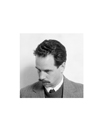



All images untitled. The thumbnails below are all at the same approximate scale.
These photographs mimic photos of patients with various psychologically induced paralyses and ticks. The source photographs were published in the French psychiatric journal Nouvelle Iconography de la Salpêtrière (1888–1918) which was founded by the French neurologist Jean-Martin Charcot.
In my photos I took the place of the patients. These photos were shot with Type 55 Polaroid film, which included a film negative and a paper positive, allowing me to reproduce the pose and gestures of the original subject very closely. I chose clothing that seems to be a contemporary equivalent to what the patients are wearing. The photographs are printed half life-sized. This gives them a unique relationship to the viewer, as a person's reflection in the mirror is always half-sized, regardless of their distance from the mirror. (You can test this by marking the reflection of the top of your head and the bottom of your chin on a mirror with tape. When you back up the reflection of your head will always remain just between the two pieces of tape.) Thus, the subject in the photograph has a direct relationship to the reflection of the viewer.
This subject resonates with our contemporary situation. This search for visual evidence of mental illness seemed similar to our attempts to pin down various disorders and illnesses, often attributing them to genetics. Ultimately, this attempt to visualize mental illness was unsuccessful. This type of work was taking place just before Freud (who was a student of Charcot's) transformed psychology. Freud's linguistic based psychoanalysis displaced this visual system.
















